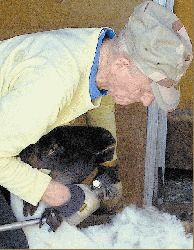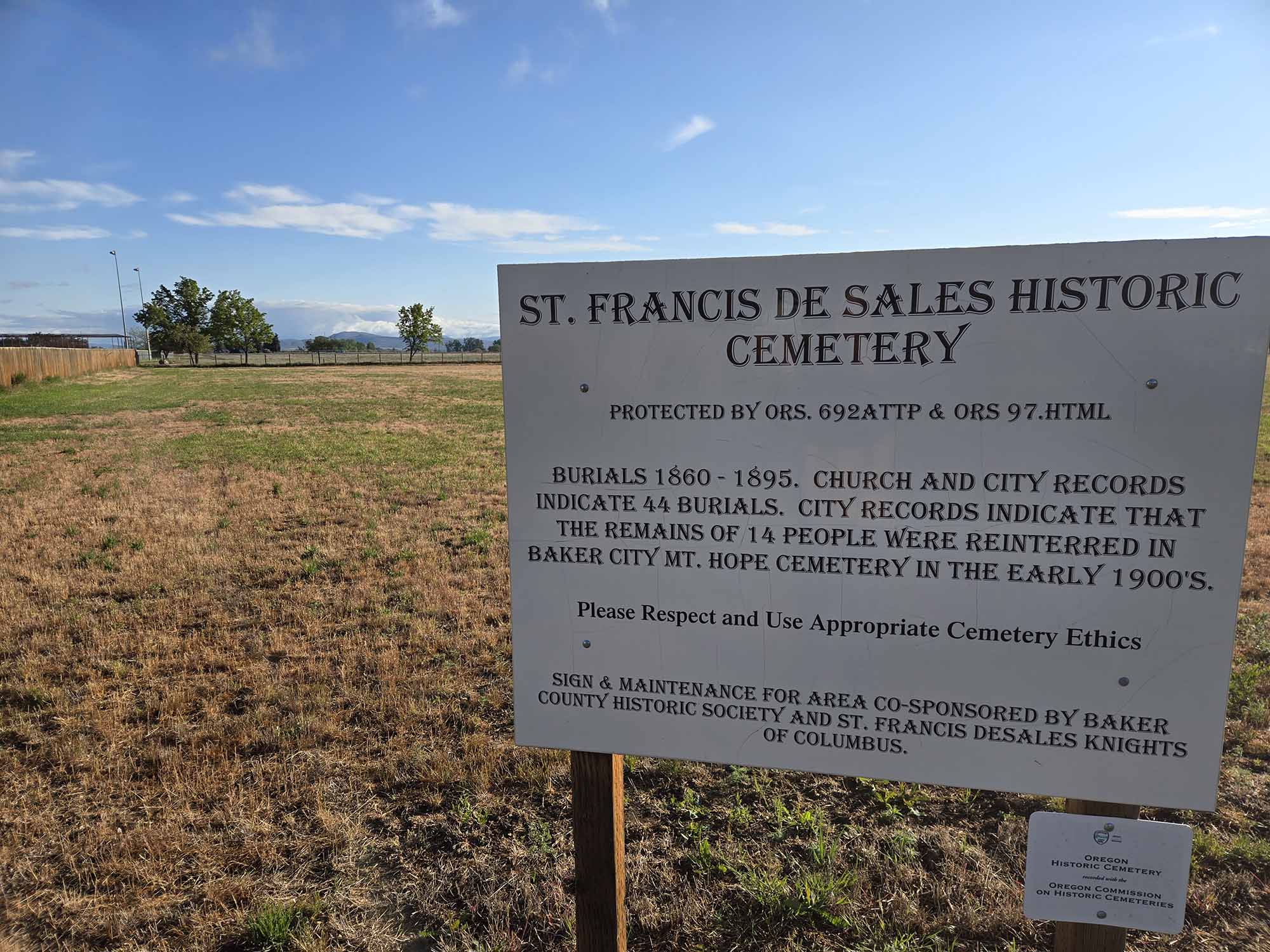Those wild, woolly days
Published 12:00 am Tuesday, June 10, 2008

- Gordon Pennington has sheared tens of thousands of sheep in his 52 years in the business (Baker City Herald/Ed Merriman).
By ED MERRIMAN
Trending
Baker City Herald
Gordon Pennington won’t talk your ear off about politics, and he won’t admit to any aches and pains, but at 76 he’s strong as a bull from a lifetime of shearing sheep.
When Pennington started shearing sheep in 1956 at age 24, Dwight Eisenhauer was president, a gallon of gas cost less than 30 cents, you could buy a full-sized pickup truck for around $1,500 or a new house for around $15,000.
Trending
And sheep shearing paid 50 cents a head.
andquot;That was big money in those days,andquot; Pennington said, adding that his money went a lot farther in the 1950s when he made 50 cents a head than it does today at $4 a head.
In his prime, Pennington said he sheared 140 to 160 head of sheep a day, for a seasonal total of $15,000 to $20,000 or more between January and mid-June, when the sheep-shearing season ended and sheep ranchers sold their wool at wool pools similar like the Tri-County Wool Pool coming up Friday, June 13 at the Union County Fairgrounds in La Grande.
At that clip, Pennington said he earned an average of $9,000 during a five-month shearing season in the 1950s, and when the price rose to 60 cents a head in the 1960s and 70 cents a head in the 1970s his earnings rose to $12,000 or more in a good season.
In those days, Pennington was part of a skilled and highly prized band of independent sheep shearers who lived a nomadic lifestyle roving around the countryside in pickup campers and travel trailers, shearing sheep from ranch to ranch across Oregon, Washington, Idaho and Nevada.
andquot;I usually had a camper on a pickup, where I could get in and stay dry and cook a meal,andquot; Pennington said.
Ranches or sheep-shearing contractors always paid at the end of each shearing job, whether it lasted a few days or several weeks, depending on the size of the sheep flock, he said.
andquot;It was a way to make pretty good money if you were good at it,andquot; Pennington said. andquot;My favorite part was traveling around to where the sheep were.andquot;
Sheep producers raised tens of thousands of sheep in Baker County and surrounding counties in Northeastern Oregon during the 50s, 60s and 70s, but Pennington said the largest concentration of sheep was in the Snake River Valley from Weiser to Grandview.
The big sheep ranches and feedlots in those days had enclosed barns or shelters where sheep were brought in out of the weather to dry off in preparation for shearing starting in January when there were large numbers of sheep to be sheared, but as the flocks shrank, the shearing season condensed down to a few weeks each spring between mid-May and mid-June, Pennington said.
Nowadays, instead of shearing up to 20,000 head during a five-month season in four states, Pennington said he sticks pretty much to Baker County, where he typically shears about 2,000 sheep. Most of those are raised by whats known as backyard sheep producers, who he says are the last of a disappearing industry and way of life.
Pennington, one of the last old-time sheep-shearers left in Baker County, said he was starting to wonder if he was going to get any calls to shear sheep this year until the phone started ringing off the hook last Friday.
That’s the day many area sheep producers learned that the 2008 Tri-County Wool Pool had been scheduled a month earlier than last year.
andquot;Calls started pouring in the last few days. Everybody wants their sheep sheared the same day,andquot; Pennington said, adding that the traditional wool pool date between the end of June and the middle of July is better suited for years like this when shearing is delayed by wet spring weather.
Unlike the old days when big sheep operations had closed shelters, Pennington said many of today’s small-scale sheep producers don’t have such indoor facilities, so shearing is more dependent on the weather.
Despite this year’s tight deadline, however, Pennington said he’s up to the task of shearing 2,000 or so Baker County sheep in time for the Wool Pool.
andquot;Last year I sheared about 2,000, but every year there is a few less sheep around because people keep selling out,andquot; Pennington said. andquot;Every year there are people I sheared for the year before who don’t have sheep anymore.
andquot;It’s sad in a way, but I guess times change,andquot; Pennington said.
At 76, youd think the 150-pound, 5-foot-9 Pennington would have trouble lifting sheep weighing up to 190 pounds and maneuvering them around for shearing, but he says it’s not a problem.
One look at Pennington and it’s plain to see he’s in excellent shape, lean as ever, with a vicelike grip honed by years of work.
andquot;Sometimes I get winded if I have to wrestle them, but that’s about it,andquot; Pennington said. andquot;My back doesn’t usually get get sore. It might be a little tired by the end of the day, but it doesn’t get sore.
andquot;The secret to shearing sheep is you’ve got to be able to twist them and turn them by yourself. The way you do that is you grab them around the nose and twist their head around to pull them over,andquot; Pennington said. The sheep might kick, but they don’t bite.
andquot;I guess they could bite you, but it’s not in their nature to bite,andquot; Pennington said, adding that the range sheep he sheared between the 1950s and the 1970s were a lot easier to work with than today’s backyard sheep.
andquot;Those range sheep are usually a lot easier to handle because they haven’t been made pets like these small flocks have,andquot; Pennington said.
With this year’s announced Tri-County Wool Pool prices of $1.05 for white face wool, 71 cents for coarse white face wool, 40 cents for black face wool, 35 cents for lambs wool, 22 cents for bellies, 12 cents for tags and crutchings and 10 cents a pound for black wool, Pennington said that’s there’s probably not enough money in the wool to pay for shearing and hauling.
andquot;The primary reason for removing the wool nowadays is it makes them a lot more comfortable by taking all that wool off,andquot; Pennington said. andquot;With the price of wool nowadays, you can’t depend on it as a cash crop.andquot;
This season Pennington got started on his first sheep shearing job Saturday with 14 head for Suzen and Jack Fors, then he moved on to shear four head belonging to one of the Fors’ neighbors.
On Monday, Pennington sheared another 35 head for Ed Rau.
andquot;We didn’t even start until 10 this morning, and we got done about 2:30 (p.m.),andquot; Pennington said.
It doesn’t take long to shear the few sheep left around here once the weather clears and you can get at it.andquot;
Pennington also shears sheep for area 4-H youths each year just before the Baker County Fair, the first week in August.
andquot;I just do it for the 4-H kids because they have to have them shorn real close just before the fair, and most of them arent able to do it themselves,andquot; Pennington said.
He’d like to find someone to train in the art of shearing sheep, but so far he hasn’t come across anyone in the younger generation interested in taking on the responsibility of shearing Baker County’s backyard sheep flocks.
I don’t know how long I will be able to do this. I can tell you I feel good now, although I dont have the energy I had 30 or 40 years ago,andquot; Pennington said.








